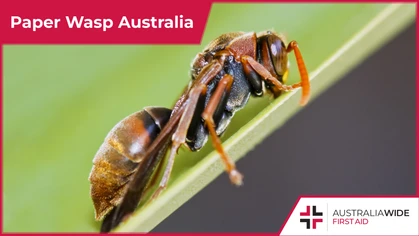Profile on the Little Whip Snake

Bites and Stings

The Little whip snake is found across south-eastern Australia. As well as belonging to the Elapidae family of venomous snakes, they are often mistaken for juvenile Brown snakes.
The Little whip snake is one of the smallest members of the Elapidae family of snakes, of which Red bellied black snakes and Death adders are also members. They have a wide distribution across south-eastern Australia, including the outer suburbs of Melbourne and Adelaide. To help you avoid a run-in with these pint-sized reptiles, let's look at their characteristics and preferred habitat. We also cover snake bites in our general and childcare first aid courses. We have training locations in every state, capital city, and major town throughout Australia. Head to our website to find and enrol in a first aid course near you today.Appearance
- A small, slender body that can reach up to 50 cm
- A black, hourglass-shaped patch that reaches from the back of the nape to between the eyes
- The scales on their back and sides can range from a tan to orangey colour and have a dark edge - the scales on their belly, meanwhile, are usually cream
Habitat
The Little whip snake (Parasuta flagellum or Suta flagellum) is distributed across south-eastern mainland Australia, from south west Victoria to south east New South Wales. Their preferred habitat includes:- Eucalypt woodlands
- Grasslands
- Stony hills
Habits
The Little whip snake is a carnivore and primarily feeds on small lizards and frogs. Females are ovoviviparous and give birth to litters of roughly seven live young between September and February.Danger
When confronted with a threat, Little whip snakes have been known to hurl their body about in a whip-like fashion and emit a foul odour. And though they are venomous, their small size and venom dosage means that their bites generally only cause mild discomfort.First aid
In saying that, it can be difficult to positively identify different types of snakes, as individuals of the same species can vary dramatically in colour, pattern, and size. As such, all snake bites should be treated as a medical emergency. If you or someone else is bitten by a snake, call Triple Zero (000) for emergency services and apply a pressure bandage as part of the Pressure Immobilisation Technique. Snake bites rarely cause fatalities due to the effectiveness of modern anti-venoms. Likewise, snakes will never go out of their way to attack you. In fact, most bites occur when a person attempts to approach, capture, or kill a snake. As such, to reduce your risk of a snake bite - leave them alone. If you need a snake relocated from your home, contact a professional snake catcher, instead.Final thoughts
To get hands-on experience in treating snake bites, head to one of our general or childcare first aid courses. We have training locations in every state, capital city, and major town throughout Australia. Head to our website to find and enrol in a first aid course near you today.
Originally published at
https://www.australiawidefirstaid.com.au/resources/little-whip-snake
as part of the Australia Wide First Aid Articles Library









